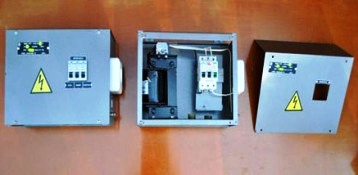Categories: Featured Articles » Novice electricians
Number of views: 57100
Comments on the article: 3
Highlights of using safe voltage in everyday life
 The risk of injuries to humans from electric shocks, both in production and in everyday life, is very high. It is a direct result of non-compliance with safety measures, as well as failure or malfunction of electrical equipment and household appliances. Therefore, the use of safe voltage for our domestic needs is difficult to overestimate. In today's article, we will consider the practice and the main possibilities of using tension safe for humans in our house, cottage or apartment.
The risk of injuries to humans from electric shocks, both in production and in everyday life, is very high. It is a direct result of non-compliance with safety measures, as well as failure or malfunction of electrical equipment and household appliances. Therefore, the use of safe voltage for our domestic needs is difficult to overestimate. In today's article, we will consider the practice and the main possibilities of using tension safe for humans in our house, cottage or apartment.
What is an electrical voltage safe for humans?
Now it is considered safe for humans to have a voltage of 42 Volts (until recently it was 36 V), used for portable lighting and household appliances in the air and in the house and 12 Volts, provided that portable lamps and appliances are used inside boilers, metal tanks, etc. .
Acceptable current for a person is considered to be the current strength at which he can independently be freed from his influence. The maximum allowable value of the current passing through the human body depends on the time of its exposure. For alternating current, with its frequency of 50 Hz, permissible touch voltage according to GOST 12.1.038-82 is only 2 V, and the current strength is only 0.3 mA. For direct current - the permissible touch voltage is only 8V, with a current strength of 1.0 mA (data are given for exposure times of less than 10 minutes per day).
Man-safe voltage levels of the electrical network in the house are obtained from our 220 V household lighting networkwhile using step-down transformers, or directly - using batteries for this with a nominal voltage of 12 and 24 Volts.
Small tensions and the nuances of their use in everyday life.
The power sources for low-voltage electric networks are step-down transformers operating from ordinary household electric networks with a voltage of 220 V, as well as 12 or 24 volt batteries. The secondary windings of step-down transformers must necessarily be zeroed and connected to the ground loop of the room, installation or electrical equipment.
Low-voltage electrical networks with voltage up to 42 V are appropriate, and sometimes it is necessary to use in the following cases:
• When suspending lighting devices with incandescent lamps at a height of less than 2.5 m, which are located in rooms with increased danger or especially dangerous rooms.
• In electrical installations, in order to reduce the risk of electric shock.
• To power electric tools used for work in rooms with increased danger.
• For power supply of electric tools used for work in especially dangerous rooms with the obligatory use of digs, galoshes and gloves.
• As a power supply network for landscape lighting of a country house or cottage, using low-voltage12v lighting system, since it is precisely such a system that now most fully meets all modern requirements of external lighting.
• To power the ultra-low safety voltage system in the bathroom by installing a step-down isolation transformer with its grounding on the low voltage side.
• For power supply damp basementin which the use of household electrical networks with a voltage of 220 V is strictly forbidden - the installation of a step-down transformer, the only way out even for powering portable lamps and other low-voltage electrical equipment.

Box with a step-down transformer YATP-0.25. The box is supplied with a socket from which portable lighting devices, various power tools, chains for spot or repair lighting with a rated power not exceeding 250 W (or 0.25 kW) can be powered.

Schematic diagram YATP-0.25.
Briefly summarizing the material presented in the article, we note the following:
• When using low-voltage electric networks with a voltage of less than 42 V, the design of their plug sockets should exclude the possibility of their inclusion in a household electric network with a voltage of 220 V.
• Do not power low-voltage portable lighting directly from step-down autotransformers.
• Checking for a possible break in the grounding conductor of power tools, as well as portable lighting fixtures, should be carried out at least once a month.
• Serious injury to people by electric shock, as well as the possibility of fires due to short circuits, are practically excluded in low-voltage electric networks.
We recommend reading:How to choose a wire cross section for 12 volt lighting networks
See also at bgv.electricianexp.com
:
